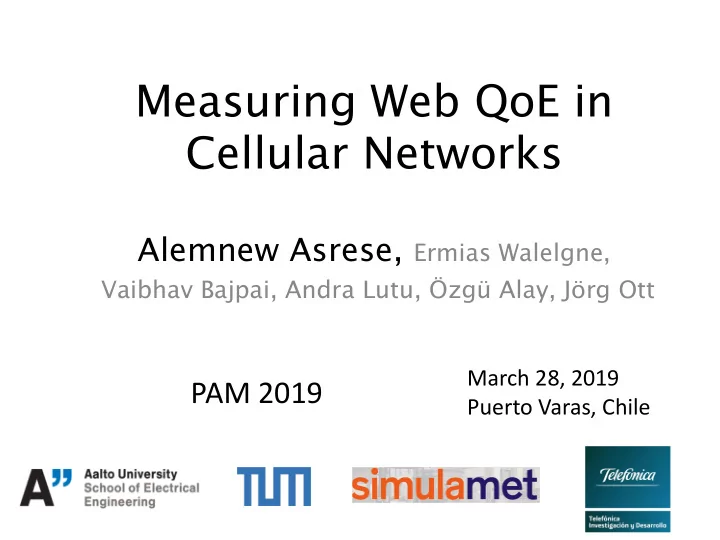

Measuring Web QoE in Cellular Networks Alemnew Asrese, Ermias Walelgne, Vaibhav Bajpai, Andra Lutu, Özgü Alay, Jörg Ott March 28, 2019 PAM 2019 Puerto Varas, Chile
5.7b MBB subcriptions in 2018. [Ericsson mobility report] Since 2016, users prefer to browse on smart phone than PC. [Jun et. Al., MobiCom’19] ISPs and content providers work to give a • good browsing experience for mobile users. New technologies, new protocols, etc • 100ms latency The effect of bad QoE cost 1% in sales is beyond personal 0.5sec delay satisfaction. dropped 20% traffic
How do we measure the user browsing experience in operational cellular networks, at scale? – SpeedChecker • Measures the traditional QoE metrics like PLT, TTFB – Meteor • Estimate the user QoE for a given app, based on a given network condition • The methodology is not open WebLAR
Agenda ü Web QoE Metrics ü WebLAR ü Results & findings ü Conclusion
Web QoE Metrics – Mean Opinion Score • Averaging the subjective user rating – Time instant metrics • Time To First Byte Traditional / Commonly • DOM time used metrics • Time to First Paint • onLoad time (PLT) • Above the fold (ATF) time – Time integral metrics • Speed Index • Object Index • Byte Index
WebLAR Enables us to measure both web QoS and QoE (time instant) metrics. - Written in Java and JavaScript - Utilizes the Chrome resource timing API - Browses a website; records timing information of the website; record video of the browsing progress; and metadata information about the network - Extract the traditional QoE metrics from the recorded timing information - Uses two approaches to approximate the ATF time. - Runs browsers in a virtualized screen (xvfb)
Two approaches to measure ATF time 1. Pixel-wise comparison approach (ATF p time ) - Comparing the pixel changes of the ATF area in the browsing session at every 100ms for 30 seconds - Different threshold for webpage stabilizing (3s, 10s, 14s) - The ATF time is the time where we see the last pixel change
t 2 t 1 t 3 t n
Two approaches to measure ATF time 2. Browser heuristic approach (ATF b time) Uses the browser timing information – API Identify the location of images in the – page ATF b time = max{To|o ∈ H ∪ J ∪ C – ∪ I ATF } , where: T : download time J : JavaScript C : Cascaded Style sheets I ATF : Images under the ATF area
The ATF time is 5.37s Credit : D. Hora, A. Asrese, et al., Narrowing the gap between QoS metrics and Web QoE using Above-the-fold metrics, PAM 2018
• Experimental platform for mobile measurement • Measurement probes – Located in ES, IT, NO, SE – Cellular, WiFi and Ethernet connectivity – Stationary (e.g., at volunteers home) or mobile (trains, buses, trucks) – Uses docker virtualization technology for running user experiment • User access and scheduling
WebLAR Experimental Workflow in MONROE platform MONROE MONROE MONROE WEB SERVERS PROBES BACK END FRONT END 1. Submit Experiment 2. Schedule Experiment 3. Change default gateway interface Repeate exp.with other MMB 5. Fetch HTTP[s] GET 4. Record Metadata Webpage Repeate for other 6. Capture resouce timing info, video of download session. websites 7. Calculate ATF time 8. Stop metadata recording STORE RESULT VIEW RESULT
Measurement • 2 weeks long measurement (May & Jul’18) • 8 websites • 128 MONROE probes with 4G connectivity • 6 operators in NO and SE • 9 probes with roaming SIM card • ~ 18K data points in total
IP path lengths towards the websites in fixed-line and LTE networks In the median case the IP path length is similar
Web Latency across operators DNS lookup time & TCP connect time varies across different MNOs
The difference in QoE across operators in small. 3 sec threshold is enough to declare the web has stabilized.
Website design and type need to be taken into consideration when applying the approaches to approximate ATF time. E.g., Facebook vs microsoft
Website design and type need to be taken into consideration when applying the approaches to approximate ATF time.
A Website may have different QoE on MNOs in a different country. Yahoo has worst performance on Norwagian operators. Home-routed roaming does not have effect on the browsing QoE, when the user tavels small distance.
Under mobility scenario, the web QoE differs across MNOs. The variation of ATF time between MNOs is higher than stationary situations.
Web QoE under stationary & mobility* condition Mobility have higher impact on ATF time that the PLT * Measured from trains and buses
Takeaways • We designed and implemented WebLAR (https://goo.gl/tUQB8T ) • DNS lookup time is similar in fixed-line and LTE networks. • TCP connect time and TTFB is longer in LTE networks • PLT and ATF time do not have significant difference across MNOs • Mobility has an impact on web QoE especially on the ATF time. • Website design should be considered in approximating the ATF time • Reproducibility considereations: https://goo.gl/Px6TQ2
WebLAR: Measuring Web QoE in Cellular Networks alemnew.asrese@aalto.fi | @alemnewsheferaw
Measured Websites News websites • – http://www.bbc.com – https://news.google.com Wiki websites • – https://en.wikipedia.org/wiki/Alan_Turing – https://www.reddit.com Social media websites • – https://www.youtube.com – https://www.facebook.com/places/Things-to-do-in- Paris-France/ 110774245616525 General websites • – https://www.microsoft.com – https://www.yahoo.com
Recommend
More recommend